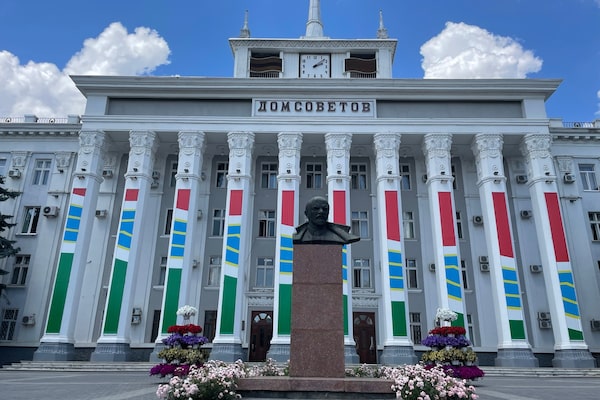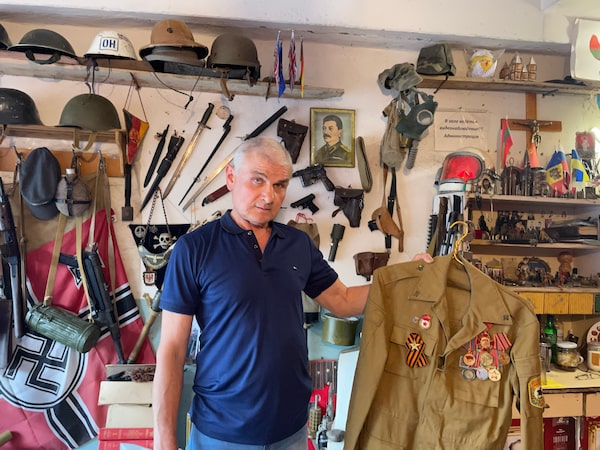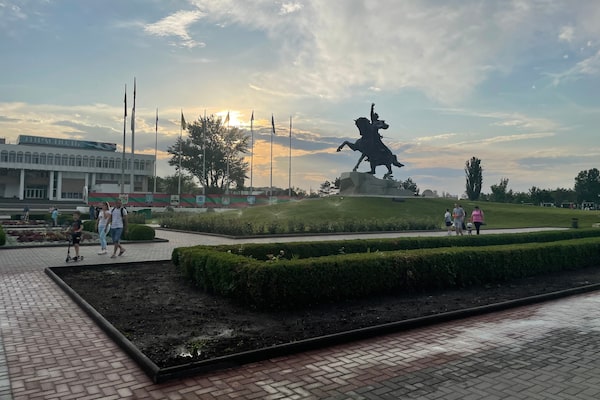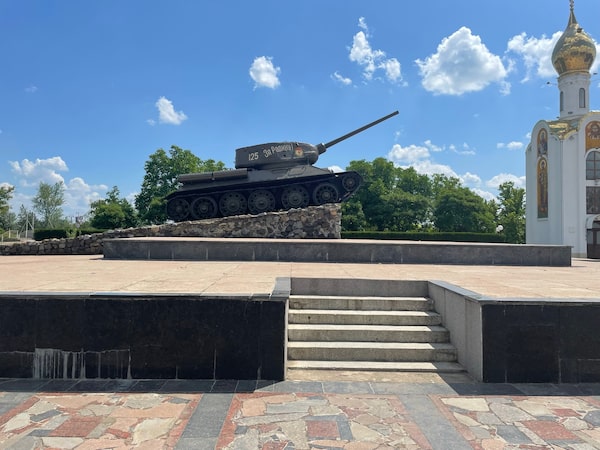
The coat of arms of Transnistria greets visitors to Tiraspol, the self-declared capital of this breakaway region of Moldova.Photography by Janice Dickson/The Globe and Mail
On a warm spring evening in Tiraspol, the capital of Transnistria, the sound of Russian music and the smell of sizzling shashliki on a barbecue filled the air. A Transnistrian flag was plastered at the entrance of a park, along with the region’s coat of arms, which prominently features a golden hammer and sickle.
Transnistria is a slice of land wedged between Ukraine and Moldova. The international community regards it as part of Moldova, but it has its own currency, passport and border control. Visiting feels like travelling back in time to the Soviet era. Russian flags are flown across the territory, and Lenin statues are commonplace.
Since a short but deadly war that ended in 1992, when separatists and pro-Moldovans fought for control over Transnistria, the two regions have become economically and socially intertwined. Transnistria benefits from Moldova’s trade agreement with the European Union, and Moldova relies on Transnistria for electricity from a power plant within its borders.
But Transnistria is primarily supported by Moscow, which has troops stationed in the region. Moldova’s pro-Western government, on the other hand, has recently begun seeking European Union membership.
Though Moldova and Transnistria have managed to co-exist for decades, the relationship became tense in February, when Moscow launched a full-scale invasion of Ukraine. A Russian commander declared in April that Moscow intended to create a land bridge from Ukraine’s Donbas region to Transnistria, which would cut off Ukraine entirely from the sea and bring war to Moldova.
Later that month, there were several unusual explosions in Transnistria. Local authorities said two radio masts that broadcast in Russian were damaged, and that the region’s security agency headquarters had been attacked. Ukraine accused Moscow of trying to pull Moldova into its war, while authorities in Transnistria blamed Ukraine.
Now Moldova is faced with a series of daunting challenges: it must manage its relationships with Transnistria and other pro-Russian elements of Moldovan society, welcome thousands of Ukrainian refugees, battle disinformation and maintain a crucial fuel-supply relationship with Moscow. A recent series of interviews with Moldovans and Transnistrians in several cities suggests that, despite the country’s efforts to balance these conflicting priorities, it remains deeply divided over the war, its causes and its consequences.
Moldova's Interior Minister, Ana Revenco.
Moldova’s Interior Minister, Ana Revenco, said in an interview that Moldova is not facing an imminent threat, but that the country has had a significant and long-term problem with Russian propaganda. “It’s seen as a very strong tool ... and it’s part of a hybrid threat,” she said.
The Moldovan government has taken steps to curb Moscow’s influence. Ms. Revenco said the country has adopted a new law on information security and is educating the public and blocking information channels that promote fake news. She noted that since the Russian invasion Moldova has become increasingly concerned about Transnistria, where she estimated stockpiles of arms and munitions total about 20,000 tonnes. Moldova remains focused on maintaining its security, providing safety to refugees and charting its pro-European course, she said.
Oleg Serebrian, Moldova’s Deputy Prime Minister for Reintegration, the ministry responsible for Transnistria, said in a statement that Russia maintains a so-called “operational group” of about 1,300 troops in the breakaway region, and that a separatist entity from Tiraspol also maintains several thousand paramilitary troops there. Moldova considers the presence of both forces to be illegal. (Russia also participates in an international peacekeeping mission in the region, established after the 1992 conflict.)

A bust of Lenin in Tiraspol, one of many symbols of the Soviet era that Transnistria has left intact after Moldova's independence from the USSR.
The Globe and Mail visited Transnistria recently, travelling undercover with the help of a guide, because the region’s government restricts visits by foreign journalists. There were checkpoints at the territory’s entrance and in Tiraspol. Police officers carried AK-47s and wore balaclavas.
The population of Transnistria is a mix of Russians, Moldovans and Ukrainians. Many who live there have family and social ties to Ukraine. Still, some are convinced that, if there were an attack on Transnistria, it would be orchestrated by Kyiv and not Moscow.
The Globe’s access to locals was limited. The guide, a local fixer who works with visiting media, had arranged interviews in advance, some of them with Transnistrians who had previously spoken with international press.

Anastasia Remarciuc sits outside a café in Tiraspol.
Anastasia Remarciuc, a 27-year-old woman with long pink hair, agreed to be interviewed spontaneously. Sitting outside a café in Tiraspol, she was wearing an off-the-shoulder Puma T-shirt. She said she was born in Transnistria. “The war in Ukraine and Russia … it’s difficult because I have so many bloods in my body – I have Ukrainian, Moldovan and Russian,” she said. “I want this stopped.” Because of her mixed heritage, she explained, she can’t take either side.
Assigning blame was easier for Andrei Platonov, a 27-year-old artist. Mr. Platonov was known to the guide, and he accompanied The Globe throughout a day of travel in Transnistria. He said Russian President Vladimir Putin is responsible for the war.
“Older people, because they’re watching TV and listening to propaganda, they believe we are some special Russian [state] which should be with Russia,” he said. Younger people form their opinions on the conflict based on other sources of information, he added.

Alexander Sinika is a collector of weapons and military memorabilia.
Inside a garage covered in old war artifacts – including a swastika flag that was pinned to a wall – The Globe met Alexander Sinika, a collector of military memorabilia who was known to the guide, and who had spoken previously with journalists.
Holding a Kalashnikov, Mr. Sinika said the West is to blame for the war in Ukraine. He pointed out that in Transnistria residents receive free gas from Russia. “Gas is everything,” he said.
If there were an attack on the region, he added, it would come from Ukraine.
His neighbour Sergei Turcenco, who like Mr. Sinika has family ties to Odesa, said in a separate interview that countries that have armed Ukraine are to blame for the war. The United States, Canada and other Western nations have sent weaponry to Kyiv, including munitions and launchers.
Like Mr. Sinika, he said he believed any attack on Transnistria would come from Ukraine or Moldova. “Everyone will stand up here” if that happens, he said.
Asked if he truly believes Ukraine and Moldova pose a threat, he replied, “It depends how much America will pay.”

A statue in Tirapsol of Alexander Suvorov, an 18th-century general who served Catherine the Great.
Vladislav Kulminski, a former Moldovan deputy prime minister for reintegration, said Ukraine and Moldova are right to see Transnistria as a potential threat.
But he added that the breakdown of the region’s population (Transnistria is 35 per cent Moldovan, 30 per cent Ukrainian and 30 per cent Russian) means Russia might have a hard time convincing locals to take up arms. “It’s very difficult to imagine that you can mobilize these people to go fight against Moldova or against Ukraine,” he said, because they have such strong connections to those places, and relatives there.
He added that the fear among Moldovans that the war in Ukraine could spill over into their country is understandable. But he believes the government has done well at keeping things calm and stable.
He noted that the war is controversial in Moldova. “Public opinion polls show that public opinion is unfortunately divided, even though this is very black and white. It’s quite clear that Russia is waging an aggressive war against Ukraine. Nevertheless, a lot of people in the country still do not see it that way.”
Mr. Kulminski credited Ukraine with protecting his country. “If, God forbid, Ukrainians do not resist, then things are going to get extremely rough for the Republic of Moldova,” he said.

A tank monument in Tiraspol honours the Soviet forces that fought against Nazi Germany in the 1940s.
Igor Munteanu, a former member of Moldova’s parliament who was once the country’s ambassador to Canada and the United States, argued that the potential threat from Transnistria should not be underestimated. The idea that people in the region are peaceful and unwilling to fight is “absolutely nonsense,” he said.
As the Russian invasion of Ukraine continues and tensions with Transnistria intensify, the Moldovan government has been working to maintain stability across the country – an increasingly challenging task, especially given Moldova’s reliance on Russia for gas.
Moldovan President Maia Sandu, a Harvard graduate who is firmly pro-European, was elected on a promise to fight corruption. She succeeded pro-Russian president Igor Dodon. Those in Moldova who would prefer the country have ties to Moscow instead of Europe are convinced she is operating on behalf of American interests. That view is common not just in Transnistria, but also in other areas of Moldova that are heavily influenced by Russia.
The flags of Moldova and Gagauzia, an autonomous region, fly near Chirsova.
Ilya Boikov, 78, sits on a Chirsova street named after Lenin.
Beside a highway in the country’s south, two flags fly next to one another: One for Moldova, another for Gagauzia, an autonomous region where residents speak the Gagauz language, as well as Russian and Romanian.
In Chirsova, a small village outside the Gagauzian capital of Comrat, Ilya Boikov, 78, sat on a bench on Lenin Street. Ukrainian President Voldymyr Zelensky “is guilty of everything,” Mr. Boikov said, adding that he’d seen this confirmed on every TV station. He said the Moldovan president is influenced by the United States. “She studied there, she’s been there, now she’s back representing their interests.”
Elsewhere in the village, Maria Dulgher and Katya Rozovoe, who are both 70, wore headscarves and walked slowly in the afternoon heat. “Zelensky’s at fault,” Ms. Rozovoe said. Ms. Dulgher, holding a bag of peppers, agreed.
Ms. Dulgher said they are worried about war coming to their village. “We live under stress. It’s very difficult. We don’t need any war,” she said. “They’re close to Odesa or in Odesa, which means it will come here as well.”
Maria Dulgher and Katya Rozovoe stop to speak with The Globe in Chirsova.
In a café in Comrat, an older man was glued to a state-owned Russian TV channel. He and a woman argued over whether or not God loves nationalists.
But it’s not just the older generation espousing these views. Several young people in Comrat said they blamed Ukraine for the war or didn’t know which side to choose.
Despite those sentiments, Gagauzia has taken in some refugees. Olga Garbuzova, a 29-year-old Ukrainian who is now living in Chirsova, said everyone there has been friendly to her and her 10-month-old daughter. She had been warned the area was pro-Russian, and that she should avoid conversations that might spark arguments. That is what she has done.
Olga Garbuzova and her 10-month-old daughter Masha.
In Chisinau, Moldova’s capital, views on who is to blame for the war in Ukraine are less divided. The Globe spoke to half a dozen young people there, most of whom said they support Maia Sandu, oppose the Russian invasion and want to see their country join the European Union.
Ms. Revenco, the Interior Minister, said the war has highlighted Moldova’s vulnerabilities, particularly its reliance on Russian energy. “Many things have not been done properly throughout the years, and it’s now really the time to transform this into an opportunity,” she said.
Although the country is pushing to join the European Union, it is not clear whether that will be possible while the conflict with Transnistria continues. “This is still a dialogue to be had,” she said.
One thing seemingly everyone in Moldova can agree on is that nobody wants war.
Rodica Volontir, a 48-year-old who works in social assistance, was sitting on a bench in Chisinau. She said division over the war is tearing families apart.
“I hope Ukraine will win,” she said. “I hope it will not come here.”
With reports from Arcadie Cotruta in Chisinau, Tim Diecker in Tiraspol and Reuters
Ukraine and beyond: More from The Globe and Mail
The Decibel
Ex-mercenary Sean McFate explains the murky origins of the Wagner Group, an outfit with ties to the Kremlin that’s accused of human-rights abuses in Ukraine, the Middle East and Africa. Subscribe for more episodes.
The Globe in Moldova
How Ukrainians are finding shelter in abandoned houses in Moldova
Roma who fled from Ukraine to Moldova face segregation, legal limbo
From our foreign correspondents
In Latvia, the battle over a Soviet monument sparks tensions
How Hong Kong could become the next hot place for Russian oligarchs to store their wealth